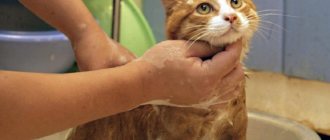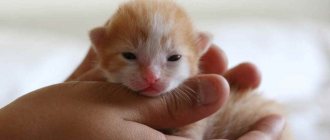Optimal time for first mating: puberty of males and female cats
The first estrus in females is recorded at the age of seven to nine months; in some breeds, puberty occurs a year or later. At this point, the cat’s body has not yet prepared for full bearing of offspring. Therefore, experts do not recommend breeding a young female during her first heat.
Consequences: difficult birth, death of the offspring, further infertility. Puberty occurs after one and a half years; it is at this time that the first mating is recommended.
Males show signs of sexual heat a little earlier; by the age of seven months they begin to actively look for a partner, but by this moment they are still growing and their skeleton is not fully formed. The cat is completely ready for breeding when it reaches one year of age.
Advantages and disadvantages of breeding cats
As with any job, raising animals has its positive and negative sides. Any animal, purebred or not, requires time, money and attention. The more cats you have, the more money you have to invest to keep them healthy and well cared for. It is necessary to soberly understand that most of the money received from the sale of cat offspring will go into business - the purchase of food, filler, vitamins, vaccinations and preparations for treatment. Of course, if you have several cats and your own cat, then the costs will be lower; you won’t have to spend money on mating with someone else’s cat. And from each cat you can get up to six kittens, so the profit will be quite good, even despite all the costs.
Breeding cats is a big commitment, you can't just breed your cat and sit around waiting for the kittens to grow up. Unfortunately, cats do not always give birth to healthy or live kittens. You always need to be prepared for the fact that you will have to keep a not entirely healthy kitten for a long time, care for it like a child, and nurse it so that it can have a good and happy life.
First you need to purchase animals. It is clear that not at the “bird market” but in a good nursery, and preferably not in Russia. Then raising them on the right food is also an expense. Then take it to exhibitions and it’s good if your animal is not rejected, because... Anything can grow, even from a super nursery on super feed. Next is payment for mating. Then raise offspring and find buyers who always want cheaper. In general, if for the sake of money, then it’s definitely not worth it. I have an unsterilized cat, I’ll tell you this, it’s not much fun, so I take her to mating once a year. More precisely, I’ll get better, I love kittens, I love playing with them, I teach them to do everything - then they follow me like dogs. But when it comes to selling, that’s where it begins... I feel sorry for the kittens, not all buyers are adequate... well, etc.
Paw
https://www.woman.ru/home/animal/thread/4184555/
They won’t pay off, club animals are very demanding, and if you are an inexperienced breeder, you will most likely suffer losses. And not all of the offspring can be sold (one spot on the skin where it shouldn’t be, and the kitten is rejected; you can only sell it for next to nothing), but for those you sell you must first find buyers. And these exhibitions are endless, all this consumes time and money.
Guest
https://www.woman.ru/home/animal/thread/4184555/
It seems to me that breeding for profit is possible, just buy a few breeds first, a Siamese or a Russian Blue. So this is very profitable, kittens can be sold from 5,000 to 20,000, and this is taking into account 1 kitten, and provided that they are from champions and with a passport, vaccinations and a chip, a kitten can be sold for (from) 25,000 to 40,000 thousand rubles
Evita
https://otvet.mail.ru/question/45696474
How to determine that a female is ready to mate
In females, the period of full maturation occurs on average at nine months of age. At this time, the cat requires increased attention from the owner. The pet asks for constant affection, begins to cuddle up to the owner, rubs its head against the legs of household members, interior items, and corners of the room.
Be sure to read:
How to calm a cat that asks for a cat at home
A pet on a spree can be easily recognized by the specific position that the animal takes, as soon as you stroke it: the stomach is pressed to the floor, the tail is raised and thrown to the side, the hind legs make rhythmic forward movements. If you pet a cat at such a moment, the pet’s body begins to tremble due to a wave of excitement.
Domestic cats during estrus begin to leave marks on the territory (rubbing their faces against all accessible surfaces) to leave their scent.
On a note! Sexual maturity of the female can begin earlier or later than nine months of age, it all depends on the breed of the animal. The mating period for yard cats lasts longer than for domestic cats.
The need for reproduction is influenced by such factors as: conditions of detention, time of year. In winter, estrus lasts several days; in spring and summer, the process can take several weeks, and here the breed plays an important role.
The cat performs its first mating without much desire. Often she does not allow the male to approach her, attacks the male, and shows aggression. This behavior is characteristic of the Scottish breed, the Sphynx.
The ability to produce offspring is fixed in females for a long time; even an elderly animal that has reached the age of 8-10 years is capable of giving birth to kittens that are in good health.
Female behavior during estrus
The reproductive instinct is inherent in the female’s body by nature. Hormones entering the animal’s blood regulate the process.
Conventionally, sexual activity can be divided into two phases:
- Anestrus (passive phase). Duration from 3.5 to 6 months. In domestic animals, the phase is shorter in duration due to the abundance of artificial light in the rooms where the pet lives. Bright light affects the hormonal cycle, therefore, domestic cats are more likely to be sexually active.
- Estrus (initial phase of sexual activity). Hormones are released into the animal’s blood, and the body is ready for sexual intercourse and fertilization. The female begins to behave in a peculiar way, trying to attract a partner: she meows loudly, invitingly, rolls on the floor on her back, spreading her legs, arches her back, showing off her genitals. As soon as you stroke the female, she gets into a position characteristic of mating.
On a note! The special structure of the body in some cat breeds leads to a protracted phase of sexual activity.
In some cases, estrus ends only during the period of ovulation (during pregnancy). These breeds can bear several litters per year.
Be sure to read:
The cat won’t let the cat near: reasons, how to create conditions for mating, what to do if it doesn’t work out
At what stage can pregnancy be determined?
So, how can you tell if your cat is pregnant? The owner can detect pregnancy in a cat starting from 28 days - during this period, the female experiences an increase in abdominal circumference, swelling of the nipples, changes in behavior, and cessation of estrus.
Ultrasound of a pregnant cat
By consulting a doctor, pregnancy can be detected from about 20 days after fertilization. For this, an ultrasound is performed, which will accurately determine the presence or absence of fetuses in the uterus.
Unlike people, cats do not secrete the hCG hormone into the blood, but instead the placenta secretes relaxin. Testing for this hormone can be done from the 20th day after mating. False-positive results are possible if the animal has an ovarian cyst.
From the 28th day you can notice the first movement of the offspring. During the same period, palpation can be carried out by palpating the side walls of the abdomen.
An X-ray of the abdominal organs is performed after 50 days of pregnancy. The method reliably diagnoses the fertilization that has occurred, and also allows you to determine the number of offspring and their position.
Why do cats scream during mating?
It takes a cat a few seconds to impregnate his partner. At this time, the cat firmly grabs the female by the withers with his teeth, without letting her go. Sexual intercourse often ends tragically for the male.
The embittered female partner screams loudly, tries to wriggle out and bite her lover on the throat, the reason is that during the mating process the female feels severe pain. As a rule, it is the cat who cries during intercourse because of painful intercourse.
The thing is that there are hard scales on the partner’s genitals that are prickly to the touch. The process of fertilization takes place as follows: the male genital organ penetrates the vagina, reaches the uterus, and is fixed there with the help of scales, which cause severe pain.
Features of caring for a pregnant cat
Pregnancy is a test for a cat’s body. Since all vital organs work in an intensive mode, the animal requires special care and attention. Favorable conditions play a big role in the course and outcome of the condition.
The cat should be kept in a spacious, well-ventilated room without drafts at a comfortable temperature. High humidity and dark lighting are unacceptable.
You should ensure that your cat does not climb onto high furniture, as a fall or awkward landing can lead to serious consequences.
In the later stages, you should help the cat with hygiene, since the large size of the abdomen does not allow the cat to carry out the necessary toileting of the genitals and fur.
From the author. If the cat is not on a natural diet, then during pregnancy and nursing it should be switched to kitten food of at least premium class, and preferably super premium or holistic. Read a separate article about the right choice of premium food for kittens.
What to feed
The general principles of feeding a pregnant cat include following some rules:
- The diet should consist of high-quality feed, rich in all necessary substances.
- It is recommended to provide easily digestible food.
- A pregnant cat requires more frequent feeding. By the second trimester, the daily norm increases by about 50%.
- In the later stages, you should resort to fractional meals 6 times a day.
- It is important to regularly check the presence of water in the drinking bowl. Dehydration leads to abortion, which can cause the death of the cat.
Also read the article about whether a pregnant cat can be sterilized.
The nuances of the first mating of cats at home
During the first mating, a domestic cat shows aggression and is capable of injuring its partner.
Animal owners should take into account a number of nuances in advance so that the mating is successful and the pet is not harmed:
- Mating should be done in the male's territory, this gives more chances for successful conception.
- Initially, the female should be left in a separate room so that the furry predator calms down and masters the new territory.
- You should have a carrier bag on hand in which you can lock an angry cat if the process does not go according to plan.
- For the first mating, animals should be selected so that one of the partners already has experience of intercourse.
- The cat's estrus at the time of mating should be in the most active phase (the first 2-3 days from the beginning of estrus).
Mating of purebred cats
Mating of purebred cats does not differ physiologically from outbred cats, but its goal is not just healthy offspring, but also maximum compliance with international breed standards. Here it is important to carefully select a stud cat, so this concern falls entirely on the shoulders of the cat’s owner.
The cat and the female cat must be of the same breed or similar breeds acceptable for crossing in the international system. For exhibitions, a good pedigree and the presence of champions and title holders are important. Inbreeding is not allowed, as this can lead to stillbirth, defects and mutations.
It is necessary to carefully consider the genetic characteristics of the manufacturer, evaluate the coat, tail length, eye color, and give preference to a cat with an exterior closest to the standard one. It is advisable to breed cats of a similar color in order to consolidate it in the kittens. The exception is white cats, since there is a high risk of manifestation of the hearing loss gene that accompanies the white coat gene.
If a cat has a deviation from the standard, then the cat should compensate for it, but not be the opposite. This means that if a cat has too small ears, this does not mean that you need to choose a cat with huge ears - this will not work. It is necessary to match the breed type.
Breeding British cats
British and Scottish cats are a bit similar. They are often confused by ordinary people, but breeders know all the differences inside out. However, Scottish Fold cats are descended from British cats as a result of a mutation in the ear cartilage, and the genotypes of the breeds are similar. Therefore, crossing them is prohibited - the risk of developing spinal pathologies is very high. British cats are bred only with cats of their own breed.
There are restrictions on mating according to color standards. There are two main groups of colors: black and red. Crossings are allowed only within the group, otherwise the kittens will be rejected. Golden Britons can only be bred with gold, sometimes with silver, and silver only with silver. The same goes for eye color: orange - with golden, copper, amber, green - only with green, the brighter the better. Blues are bred only with blues, but they carefully calculate the future color of the kittens' fur.
The round face of British cats leaves no one indifferent
Features of mating Scottish cats
The breed with folded ears is called the Scottish Fold. The main rule of mating Scots is that they are prohibited from breeding with the British and with their own breed.
Cute Scottish Fold ears
In the litter of a fold cat there are always two types of kittens: Scottish Fold and Scottish Straight. Straight are straight-eared kittens that do not participate in exhibitions and are used only for breeding - to obtain a healthy litter, you cannot breed two fold-eared animals. Otherwise, kittens are born with crooked legs, an abnormally thick tail, and death is possible.
Sphinx mating
Breeding sphinxes is a labor-intensive process. You need to have a good understanding of genetics in order to calculate the likelihood of dangerous mutations in future kittens based on the external data of the parents. The line between standard and deviation is extremely thin. Not all kittens in a litter will inherit the hairless gene; in some it will be hidden.
Since this breed appeared as a result of a mutation, there are frequent cases of the birth of unhealthy offspring. Therefore, hairless sphinxes are allowed to mate with velor or brush sphinxes with short hair, which have the remaining characteristics of the breed: thin long legs, slanted eyes, huge ears, high cheekbones, sharp muzzle with a weakly defined chin.
Graceful thin-legged sphinxes
Mating and conception: how it happens
The animals get to know each other, if the cat does not show aggression, the male begins to emit an inviting howl, the female meows in response, and takes a specific pose.
The partner jumps on the cat, grabs it by the withers with his teeth, holds it tightly with his front paws, inserts the genitals into the vagina, freezes, begins to make forward movements until seminal fluid is released, mating time is 1-2 minutes. Repetition of sexual intercourse occurs after 15-25 minutes; cats are able to mate 6-9 times per day.
Be sure to read:
Mating a British cat: features, preparation, optimal period, how they behave, what not to do
The period of conception begins the next day after sexual intercourse.
How to prepare for mating
To prepare for successful mating, you should carefully monitor the condition of your furry pet. At the very beginning of the hunt, it is necessary to deliver the cat to the partner. An unfamiliar place can cause stress in the female, which may cause her to stop estrus.
Signs of a fertilized individual: the cat stops fawning, rolling on the floor, screaming, and calmly bears the offspring.
How do street animals reproduce?
In the active phase, the female’s body begins to produce a hormonal secretion with a specific odor; sexually mature males flock to the emitted aroma. The cats begin to fight for the right to mate with the cat, the animals scream loudly, arch their backs, and get into fights.
The female watches the fight, selecting a partner; it can be the cat she likes or the winner of the fight. The cat's tactics boil down to trying to get close to the object of desire. The cat gradually approaches the female, trying not to look at her; when approaching as close as possible, the cat screams angrily; if the female does not show aggression, mating occurs.











